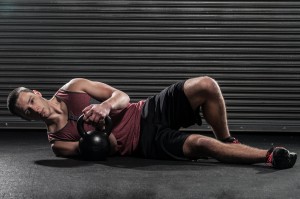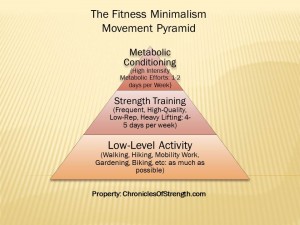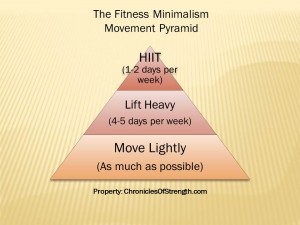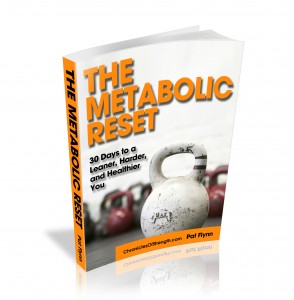This post started as an email sent to all my delicious readers some two or three days ago, can’t remember, but it generated such a stirring response that I thought it worthy of elaboration.
The chief aim of this post is to provide some instructions on how to make your own minimalist training program, should that be something you’re into. My only worry is that the bulk of folks who read these simple instructions will do what is very nearly always done, and complicate it.
It is alarming that whenever something simple is presented in the ways of fitness, strength, and health, how it must first be made into an intricate, convoluted, and preposterous abomination before it ever becomes believable or taken in by a turdy fitness magazine. But this, of course, is wrong. Waving variables and odd percentages do not make for a good or clever training program. They may look like they make for a good or clever training program to the eye of the uninformed and inexperienced, in the way that a piece of congressional literature looks like good writing to the eye of an idiot, which is to say, to the eye of a congressman, but anybody with a fitness IQ above 17, which brings us down to around 3% of the American population, can easily tell otherwise.
The following instructions are simple. Please keep them that way. If you have any specific questions, ask them in the comment section, and I will be happy to help you out.
Fitness Minimalism: The What and the Why
As a minimalist, and with minimalist training, the goal, always and foremost, is to exercise for health, and not for the sole sake of getting better at exercise.
Meaning, the goal of exercise is to fatigue the muscles, and to stimulate positive, healthy growth. Therefore, the priority should never be reps or load, but quality, because precision must precede power if you want your efforts to amount to anything meaningful.
Ultimately, minimalism is where effectiveness meets efficiency, or the point where we have found the least amount we have to do to be successful.
When I say minimalism is effectiveness meets efficiency, here is what I mean.
Effectiveness is doing the right things. There are forty three billion exercises in existence today, last I counted, and you really only need about 20 of them to be successful, maybe less. These exercises, I refer to as the “vital few”, and all the rest, “the trivial many”. The fundamental mission of a minimalist, therefore, is to focus his efforts on the vital few—the movements proven to produce the greatest results.
What are these movements?
Well, I’d like to approach this first by separating movement out its most fundamental components, which are:
Push
Pull
Hinge
Squat
Rotation
Locomotion
Direct Ab Work (Not usually included, but I think it’s important)
From here, we can venture a few specific movements (by no means all inclusive).
Push: Push Up (horizontal) or Military Press (vertical)
Pull: Bodyweight Row (horizontal) or Chin Up (vertical)
Hinge: Single Leg Deadlift
Squat: Front Squat
Rotation: Windshield Wiper
Locomotion: Bear Crawls
Direct Ab Work: Hanging Leg Raise
There are, of course, a few other movements we could swap in here or there, but those listed above, I assure you, could get anybody all the results they could ever want, and then some, if worked properly…which brings me to my next point.
Efficiency means doing things right. Just selecting the right movements isn’t enough, you also have to work them in the right way. This means performing them with faultless form, and selecting the appropriate training variables—density, volume, intensity, duration, etc (please see below).
So when you have selected the right exercises (chosen to be effective) and then you have adjusted all the variables to the point where you are doing the least amount you need to do to be successful (chosen to be efficient) you have then arrived at what I would call a minimalist training program.
Sometimes people get it mixed up, and think minimalism is all about being lazy. This is a mistake. Minimalism is about being selective, sensible, and concise. Has nothing to do with being lazy.
But still, why work harder, if you don’t have too?
Exercise is a stressor, and little good ever comes from overstressing yourself. Quite literally, if you over exercise, you are shaving years off your life.
And the formula for a healthy, strong life is really quite simple. I’ve shared it before, but I want you to have it again. It is as follows:
Frequent low-rep, high-quality strength training (4-5 days per week) + Less frequent high intensity metabolic conditioning (1-2 days per week) + As much low-intensity cardiovascular activity as possible (brisk walking, hiking, gardening, etc).
In other words: lift heavy a good deal of the time. Work your ass off some of the time. And move lightly, very nearly all of the time.
Sample Day
I’m not going to lay out a very basic sample day for you—not an entire program, you’ll have to join the Inner Circle for that, but at least a day.
[If you’d like an entire program written out for you, I have the full The Metabolic Reset and nutrition protocol (see below) coming out to all Inner Circle on November 1st. CLICK HERE to try it out (cancel anytime).]
Let’s begin.
Day 1 Strength Routine:
Push/Pull:
Double Clean and Press x 1,2,3,1,2,3
Pull Up (Weight as needed) x 1,2,3,1,2,3
Hinge/Squat:
Single Leg Deadlift x 1,2,3,1,2,3
Double Kettlebell Front Squat x 1,2,3,1,2,3
Direct Ab & Rotation:
Hanging Leg Raise x 5 x 5
Windshield Wiper x 5 x 5
Locomotion:
Bear Crawl x 50 meters x 3-5 rounds (to make this more difficult, don’t focus on speeding it up, but slowing it down).
Metabolic Conditioning Routine:
The Beastmother
Low Level Activity:
Brisk Walk (30-60 minutes) first thing in the morning and before eating.
Another Brisk Walk (30-60 minutes) immediately post workout and before post workout meal.
Clustered movements you may perform in a superset, meaning back to back with no reset in between.
Frequently Asked Questions
- How Heavy Should I Go?Unless you are a complete greenhorn, work with a weight that is between your 5-7 rep max for each applicable movement, and for three months, don’t up the weight. This way you start with a “heavy load” and finish with a “light(er) load”. Effectively, you have then waved the load by not waving it at all.
- What If I Don’t Have Weights. Can I Use Bodyweight Exercises?Of course, just select the most appropriate bodyweight variations for each movement pattern that would be equal to your 5-7 rep max. This might require that instead of push ups you do one arm push ups, instead of bodyweight squats, pistol squats, etc, etc.
- Is The Brisk Walking Really Necessary?I think so, yes. Not only does it help to increase AND prolong the fat-burning effects of exercise and fasting, and promote recovery from strenuous exercise, brisk walking is too very therapeutic for the mind. I would really prefer if you did your brisk walking outdoors, too.
Any other questions? Please drop them in the comment section.
The Metabolic Reset: 30 Days to a Leaner, Harder, Healthier You
As many of you already know, the new Metabolic Reset will be released to all Inner Circle members as the newsletter this month. The purpose of me writing this program was to provide the most clear and concise instructions on fitness minimalism, fasting, and nutrition–so that you can essentially just “plug in and play”.
It will be released this Friday. CLICK HERE to join the Inner Circle now, so you don’t miss out.
Here is what you will discover inside The Metabolic Reset:
- The Met-Reset Strength Training Program (5 exercises, days per week)
- The Met-Reset Metabolic Conditioning Program (My 3 favorite fat-blasting metabolic routines, 2 days per week)
- The 30 Day Met-Reset Nutritional Protocol (STRICT for 30 Days–a combination of fasting and primal eating)
The 30-Day Met-Reset Body Transformation Challenge
The 30-Day Met-Reset Body Transformation Challenge is a chance for you to make a full commitment to getting the body and health you deserve. This commit will be made to me, and as an Inner Circle member, I will be there to help you out however I can along the way.
The 30-Day Met-Reset Challenge is also a chance to win:
- One month of Private Online Coaching with Me
- A Signed Copy of Paleo Workotus for Dummies (Hits stores Nov 25th)
- A Chance To Be in My Next Published Book
Here’s How to Enter:
- Sign up at the Inner Circle HERE.
- Shoot me an email (PatFlynn@ChroniclesOfStrength.com) with the Subject line of “I’m In”.
The deadline to enter is Tonight (Oct 31st) at Midnight.





Pat do you have any videos of the bear crawl? Thanks. Looking forward to the thirty day challenge
Hey Jack, yes I do. Here you go: http://www.youtube.com/watch?v=HIE9fXVscaI
Pat so do you ever take Deload weeks or a week completely off ?
Scott, sometimes I do, yes. This is always as I feel necessary, never planned. I’ve learned to tune into my body quite well over the years, and recognize the signs of when it’s necessary to take some time off. These may include a drop in energy, libido, performance, etc.
It really goes back to the old adage of “listen to your body”. It will tell you when its time to cool your jets. You just have to listen.
Pat, I appreciate your mostly sensible and effective presentations. I do think that 4-5 days of heavy strength training per week is too much for older bodies, and that includes anyone over 35-40. I am 54 and move every day, but that frequency of strength training would not allow for proper recovery. You will see when you are older! The 50’s is a whole other ballgame in terms of recovery! Less is truly more! Thank you for sharing quality information!
Brian, having never worked with you, I will not speak for your particular case, but on the main, I disagree.
The 4-5 days of heavy lifting is not your traditional balls to the walls heavy lifting. The volume is spread out very thinly, the density is also quite low, so, therefore, the frequency can be a little higher. I have many, many older clients–some even in their 70s–who are using this type of program with great success, with no problems, and who recovery adequately.
That being said, some may need to take the time to work up to this, no doubt–especially if they are new to the game. And also it is doubtless that some might be able to get away with less. This, of course, is always the problem with venturing general prescriptions to the masses, there are always exceptions. But my experience, working with all walks and ages of life, has found the above to be the closest thing to “just right” for MOST people–not too hot, not too cold.
Have you tried this program?
If so, and if it was too much for you, let me know, and I’d be happy to help you make some tweaks.
Keep strong!
Brian, Pat is not kidding. I’m 56 and I can do this with no problem. I lift pretty heavy and do some highly strenuous workouts. The key for meis in making sure I go to bed by 10:00PM and no later. In other words get plenty of rest, yes we’re not 25 anymore but believe you me, I can out-lift my sons who are at that age. I can’t run faster then they do though 🙂
The importance of good nutrition can not be discarded either. If you are not up to it yet, give it some time and as Pat says, work up to it. I especially love the walking, it’s good recovery for me.
Hey Otto, thanks for sharing your experience–it’s valued.
Great to hear you’re having such success. Keep strong, my friend.
What are a few good bodyweight variations on the single leg Deadlift? I find that just doing the movement without weight is too easy to call heavy lifting and I often don’t have a well-equipped gym available.
Hey Joe, look up the Harop curl, definitely one of the more challenge bodyweight movements for the posterior chain. I have a vid on my youtube channel, try searching there. Thanks.
Pat: As an athlete in training at age 59, I’m with you. You’re body doesn’t know it’s 50+ (or 60+, 70+, etc.) until your own grey matter brainwashes you into the
“I’m an old man and must ease back” mentality. Want to find that fountain of youth that wack job Ponce de leon was chasing ? Keep pushing and exploring your limits, otherwise you’ll shrink – physically, mentally, spiritually.
James, so true. I have trained under numerous coaches well into their 50s and 60s, all amazingly fit and healthy and they all pretty much say the same thing to say: that our aging is the result of false beliefs and negative thinking(we literally think ourselves into being old…), which in turn leads to deleterious actions/behaviors/habits. In this sense, aging can be separated out into chronological and biological aging–the former we can do nothing about, the latter we can combat to a great extent.
This was confirmed to me again this weekend when I had the pleasure to train with another great coach, Steve Maxwell, who is now, I believe, 62 or 63 years old, still lifting heavy, and still moving everyday. What’s more is he too follows a very similar routine as this , and attribute his youthfulness very nearly entirely too it.
Thank you for chiming in, always great to hear successes such as these. Keep strong!
Which would be better in comparison to the birth of a hero where there is a constant increase in intensity, density & volume and this work out plan where the weight remains the same? Is one preferable over another? BTW I’m 62 and have been lifting heavy, out helps my pain and keeps me moving, thanks Pat for your honest simplicity.
Hi
First of all I think you make a lot of sense and your performance on kettlebell complexes is admirable.
Minimalism brings to mind two thoughts – simplicity and not doing a lot of volume. the two dont necessarily match. One can follow fairly simple ideas and still spend a lot of time training. Your recipe (one possible interpretation) of 5 strength sessions, a couple of metabolic sessions and a lot of easy cardio could indeed be a lot of volume and time in the gym/on the track or road. So the following is not necessarily a critique f your recipe, just a thought for those who are deciding how to programme.
**********
BY GREG NUCKOLS AND DR. MIKE ISRAETEL
Lately, it seems as if social media is being flooded with a new trend: minimalism. What is minimalism, why is it gaining popularity, is it really the right way to train/diet, and if not, what is?
WHAT IS MINIMALISM?
In the world of training and diet, minimalism is defined as doing the least amount of work to get a certain result. We agree 100% with that definition, and think that it’s a very useful concept. However, this is often construed – wrongly – to mean (especially in powerlifting training) ONLY doing the big three lifts (squat, bench, and deadlift), or perhaps adding some basic assistance work to those, and above all, keeping the total training volumes and frequencies low.
WHY THE POPULARITY?
We’re not 100% certain why minimalism has been enjoying a resurgence of popularity but we think a big part of the reason is quite obvious: it’s easier. If training less can get you as good of results as training more, doesn’t training less sound like a much better option? After all, there are numerous other fun and productive things you can do with your time other than training, and if training more is NOT better, then why spend needless hours in the gym?
And of course these ideas are being discussed in the age of the internet. People are more apt to click on an article titled “Get stronger in just 20 minutes per day” than “work harder to get stronger.” The incentive is not on truth but on traffic. And unfortunately the truth often isn’t nearly as clickable.
REALITY
So does minimalism really work? Do minimalists have it right after all? Can you do less work, not fret about the details, and still get the results of more tedious approaches? It often boils down to your goals.
If you want to generally get bigger and stronger while improving your body composition, then the popular minimalistic may be just what you need.
However, if you want to compete in strength sports or bodybuilding at the highest levels, and approach your genetic potential, a minimalistic approach will only get you but so far. Past that point, you will need to do more work – more total volume to keep strength and size gains coming once your body has fully adapted to the low stimulus of minimalist programs, and more exercise variety to address weaknesses that can develop over time.
Also, (and this is a crucial point) let it be known that we don’t think there’s any point in doing more than you need to do in order to reach your goals. Extra work for its own sake serves no purpose. However, the minimal work necessary to reach your goals depends largely on what you goals are. If you have lofty goals, your “minimalism” will be a heck of a lot more complicated than someone just looking to make some improvements and get in a little better shape. So what does “minimalism” look like if you want to approach your full potential?
From the perspective of training, if you want to be as good as you can be, the theory is quite simple: do as much as you can recover from/adapt to. Now, how much is that? Well, research tells us that it’s A LOT. Multiple reviews of the literature have confirmed that more work in the gym (more sets per session and per week) almost always lead to more muscle growth and strength improvement (1,2,3,4). Training hard enough to begin to bump up against your ability to recover and adapt actually turns out to be quite challenging, and especially for more advanced lifters turns into a LOT of work. Sets and sets and sets of (especially) the heavy basics. Is it enough to do 3×5 in the squat and go home? If you’re a novice and you want to get a bit stronger, almost certainly… if you’re an intermediate or advanced lifter and you’re trying to PR, almost certainly NOT.
If you feel like you can’t recover/adapt to your attempted training volume, the first move shouldn’t be to reduce your training volume… it’s to take a look at your recovery strategies. Are you sleeping enough, are you eating well, and are your supplements in order? If you’re stalling, the proper path moving forward is almost always more emphasis on recovery – not less work in the gym.
TRADEOFFS
Pretending you’re doing all you can when you’re really not. That’s really what this article is about. We have no problem with a varied spectrum of personal choices, we only have a problem with contradictions. It’s absolutely A-Okay to say that powerlifting or fitness or bodybuilding is important to you, but not always (or even sometimes) priority number 1. It’s a hobby for almost all of us after all! So if you only want to train a few times a week for less than an hour per session, we’re not stopping you! Just realize that you’re making a trade-off. Training a couple times per week for an hour at a time is certainly enough to get bigger and stronger for most people. You can make it a long way with a minimum input of resources (the 80/20 rule absolutely applies here), but you will not be as good as you could possibly be.
People who want to reach their full potential, on the other hand, need to learn to embrace the oft-maligned 20% in the 80/20 rule. You WILL hit a point of diminishing returns, but smaller marginal returns are still returns. You may get 60% of your possible growth from a workout with your first set, another 20% from set 2, another 10% from set 3, 4% for set 4, and 2% for sets 5, 6, and 7.
Applying the 80/20 rule, you’d be good to go with just doing 2 sets – almost all the growth stimulus, with substantially less time spent in the gym.
If you want to be the best you can be, though, you need to embrace the meager returns on the last several sets. In this hypothetical scenario, for you, 7 sets would meet the definition of minimalism. No point in doing an 8th set, but also no point in skimping on 2% of the possible benefits if your goal is to maximize results.
The hard truth is that if you actually commit yourself FULLY to powerlifting, fitness, or bodybuilding success, you’re going to need to do more work, not less. You’re going to have to train… A LOT… hours and hours of highly fatiguing work per day, and on most days of the week. Not immediately, obviously, but just be aware that months or years down the road that’s where the pursuit of excellence will lead.
Telling people how committed to success you are AND simultaneously following a minimalist training plan seems like the best of both worlds. You get recognition and praise for commitment while avoiding the burden of more work and complexity. In reality, minimalist training won’t make you the best you can be, and after other lifters surpass you (those who are committed to the reality of difficulty that is strength and physique sport), you won’t have much of the bragging rights to commitment either.
If you want to be the best you can be, be prepared to train hard and often. If you want to be the best you can be, be prepared to pay the price. But please, don’t pretend that training 3x a week for an hour or less is making you the best. We wish it were so, but unfortunately, it just isn’t.